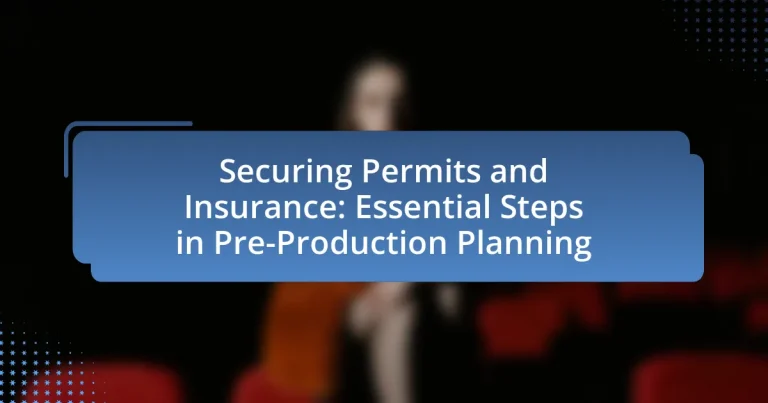The article focuses on the essential steps for securing permits and insurance during the pre-production planning phase of film and media projects. It outlines the importance of identifying necessary permits, such as location and filming permits, and emphasizes the need for appropriate insurance coverage, including general liability and workers’ compensation. The article discusses the impact of local regulations on the permitting process, common challenges faced, and best practices for effective communication with local authorities. Additionally, it highlights strategies for expediting the permitting process and the financial implications of inadequate insurance coverage, providing a comprehensive guide for filmmakers to navigate these critical aspects of production planning.

What are the essential steps in securing permits and insurance for pre-production planning?
The essential steps in securing permits and insurance for pre-production planning include identifying necessary permits, applying for them, and obtaining appropriate insurance coverage. First, filmmakers must research local regulations to determine which permits are required for their specific project, such as location permits, filming permits, and any special permits for stunts or aerial shots. Next, they should complete and submit the permit applications to the relevant authorities, ensuring all required documentation is included to avoid delays. Concurrently, filmmakers must assess their insurance needs, which typically include general liability insurance, equipment insurance, and workers’ compensation. They should consult with an insurance broker experienced in the film industry to secure the necessary coverage that protects against potential risks during production. These steps are crucial as they ensure compliance with legal requirements and safeguard the production against unforeseen incidents.
Why is securing permits crucial in the pre-production phase?
Securing permits is crucial in the pre-production phase because it ensures legal compliance and avoids potential fines or project delays. Without the necessary permits, production activities may be halted by authorities, leading to increased costs and scheduling conflicts. For instance, filming in public spaces typically requires permits to ensure that local regulations are followed, which can include safety measures and noise control. Additionally, obtaining permits often involves a review process that can take weeks or months, making early acquisition essential for maintaining the production timeline.
What types of permits are typically required for different productions?
Different productions typically require various types of permits, including location permits, filming permits, and special effects permits. Location permits are necessary for filming on private or public property, ensuring that the production has the right to use the space. Filming permits are often mandated by local governments to regulate the filming process, ensuring compliance with safety and zoning laws. Special effects permits are required when a production involves pyrotechnics, stunts, or other potentially hazardous activities, ensuring that safety protocols are followed. These permits are essential to avoid legal issues and ensure a smooth production process.
How do local regulations impact the permitting process?
Local regulations significantly influence the permitting process by establishing specific requirements and standards that must be met for approval. These regulations can dictate zoning laws, environmental assessments, and safety codes, which directly affect the timeline and complexity of obtaining permits. For instance, a study by the National Association of Home Builders found that local regulations can add an average of 7 to 10 months to the permitting timeline for construction projects. This demonstrates that adherence to local regulations is crucial for ensuring compliance and avoiding delays in the permitting process.
What role does insurance play in pre-production planning?
Insurance plays a critical role in pre-production planning by mitigating financial risks associated with film and media projects. It protects against potential losses from accidents, equipment damage, or liability claims that may arise during production. For instance, production insurance can cover costs related to property damage, injuries to cast and crew, and unforeseen delays, ensuring that the project can proceed without significant financial setbacks. According to the Producers Guild of America, obtaining appropriate insurance is essential for securing financing and permits, as it demonstrates to stakeholders that risks are managed effectively.
What types of insurance are necessary for film and production projects?
Film and production projects require several types of insurance to mitigate risks. The essential types include general liability insurance, which protects against third-party claims for bodily injury or property damage; equipment insurance, covering loss or damage to production equipment; and workers’ compensation insurance, mandated by law to cover employee injuries. Additionally, errors and omissions insurance is crucial for protecting against claims of copyright infringement or breach of contract. These insurance types are vital as they safeguard the production against financial losses and legal liabilities, ensuring a smoother production process.
How can insurance protect against potential risks during production?
Insurance protects against potential risks during production by providing financial coverage for losses or damages that may occur. This coverage can include protection against equipment failure, liability claims, and property damage, ensuring that production companies can recover financially from unforeseen incidents. For instance, general liability insurance can cover legal fees and settlements if a third party is injured on set, while property insurance can reimburse for damaged equipment, allowing production to continue with minimal financial disruption. According to the Insurance Information Institute, businesses that invest in appropriate insurance can mitigate risks effectively, leading to increased stability and confidence in production activities.
What are the common challenges faced when securing permits and insurance?
Common challenges faced when securing permits and insurance include navigating complex regulations, meeting varying local requirements, and managing time constraints. Regulatory complexity arises from differing laws across jurisdictions, which can lead to confusion and delays. Local requirements often vary significantly, making it difficult for applicants to ensure compliance. Additionally, time constraints can pressure individuals or organizations to rush through the process, potentially resulting in incomplete applications or overlooked details. These factors collectively contribute to the difficulties encountered in obtaining necessary permits and insurance for projects.
How can delays in obtaining permits affect the production timeline?
Delays in obtaining permits can significantly extend the production timeline. When permits are not secured on time, scheduled activities may be postponed, leading to a domino effect that disrupts the entire production schedule. For instance, a study by the Project Management Institute found that 30% of project delays are attributed to permitting issues, which can result in increased costs and resource allocation challenges. Consequently, the inability to proceed as planned can lead to missed deadlines and potential financial penalties, underscoring the critical importance of timely permit acquisition in pre-production planning.
What are the financial implications of inadequate insurance coverage?
Inadequate insurance coverage can lead to significant financial repercussions, including substantial out-of-pocket expenses for damages or liabilities that exceed policy limits. When individuals or businesses face unexpected events, such as accidents or natural disasters, insufficient coverage may result in costs that are not covered by insurance, leading to financial strain or bankruptcy. For instance, a study by the Insurance Information Institute indicates that nearly 40% of small businesses that experience a disaster without adequate insurance coverage fail within a year. This statistic underscores the critical importance of having sufficient insurance to mitigate financial risks associated with unforeseen events.

How can one effectively navigate the permitting process?
To effectively navigate the permitting process, one should thoroughly research local regulations and requirements specific to the project type. Understanding the jurisdiction’s guidelines ensures compliance and helps identify necessary permits early in the planning phase. For instance, many municipalities provide online resources or contact points for inquiries, which can clarify specific documentation and timelines required for approval. Engaging with local authorities early can also facilitate smoother communication and expedite the process, as they can provide insights into common pitfalls and necessary adjustments.
What steps should be taken to apply for permits?
To apply for permits, first identify the specific type of permit required for your project, as different activities necessitate different permits. Next, gather all necessary documentation, which may include project plans, environmental assessments, and proof of insurance. After compiling the required documents, submit the application to the relevant local, state, or federal authority, ensuring that all forms are completed accurately. Finally, pay any associated fees and await approval, which may involve a review process or public hearings, depending on the permit type. This structured approach is essential for compliance with legal regulations and successful project execution.
How can one gather the necessary documentation for permit applications?
To gather the necessary documentation for permit applications, one should first identify the specific permits required for the project, which can vary based on location and type of activity. Next, collect essential documents such as proof of ownership or lease agreements, site plans, project descriptions, and any relevant environmental assessments. Additionally, consulting local government websites or offices can provide specific requirements and guidelines for documentation. This approach ensures compliance with local regulations and streamlines the application process.
What are the best practices for communicating with local authorities?
The best practices for communicating with local authorities include being clear, concise, and respectful in all interactions. Establishing a direct line of communication, such as email or phone, ensures that inquiries and requests are addressed promptly. Providing all necessary documentation upfront, including project details and timelines, facilitates a smoother approval process. Additionally, understanding local regulations and demonstrating compliance can build trust and foster a positive relationship. Engaging in regular follow-ups shows commitment and helps to keep the lines of communication open. These practices are supported by the fact that effective communication can significantly reduce delays in obtaining permits, as evidenced by case studies in urban planning where streamlined communication led to faster project approvals.
What strategies can help expedite the permitting process?
To expedite the permitting process, stakeholders should implement strategies such as early engagement with permitting authorities, thorough preparation of application materials, and utilizing technology for tracking and communication. Early engagement allows for understanding specific requirements and potential obstacles, which can streamline the application process. Thorough preparation ensures that all necessary documentation is complete and accurate, reducing the likelihood of delays due to missing information. Additionally, leveraging technology, such as project management software, can enhance communication and tracking of the application status, facilitating quicker responses and resolutions. These strategies have been shown to significantly reduce processing times in various projects, as evidenced by case studies in urban development where proactive measures led to a 30% decrease in permitting delays.
How can early planning and research minimize delays?
Early planning and research can minimize delays by identifying potential obstacles and streamlining processes before they arise. By conducting thorough research on necessary permits and insurance requirements, project managers can anticipate regulatory hurdles and allocate sufficient time for approvals. For instance, a study by the Project Management Institute found that projects with detailed upfront planning are 20% more likely to meet deadlines. This proactive approach allows teams to address issues early, reducing the likelihood of last-minute complications that can cause significant delays.
What resources are available to assist with the permitting process?
Resources available to assist with the permitting process include government websites, local planning departments, and industry-specific organizations. Government websites often provide guidelines, application forms, and contact information for relevant officials, while local planning departments can offer personalized assistance and clarification on local regulations. Additionally, industry-specific organizations may provide resources such as workshops, templates, and expert consultations to navigate the permitting landscape effectively. These resources are essential for ensuring compliance and streamlining the permitting process.

What best practices should be followed for securing insurance in pre-production?
To secure insurance in pre-production, it is essential to conduct thorough risk assessments and identify potential liabilities associated with the project. This involves evaluating locations, equipment, and personnel to determine the necessary coverage types, such as general liability, workers’ compensation, and equipment insurance. Additionally, obtaining quotes from multiple insurance providers ensures competitive rates and comprehensive coverage options. It is also crucial to review the insurance policies carefully to understand exclusions and limits, ensuring they align with the specific needs of the production. Engaging an insurance broker with experience in the film industry can provide valuable insights and facilitate the process of securing appropriate coverage.
How can one assess the insurance needs for a production?
To assess the insurance needs for a production, one must evaluate the specific risks associated with the production activities. This involves identifying potential hazards, such as equipment failure, accidents on set, or liability issues related to cast and crew. A thorough risk assessment should be conducted, which includes reviewing the production’s scale, location, and type of activities involved.
For instance, a large-scale film production may require different coverage compared to a small independent project. Additionally, consulting with an insurance broker who specializes in entertainment can provide insights into the necessary coverage types, such as general liability, workers’ compensation, and equipment insurance. This approach ensures that all potential risks are accounted for, leading to a comprehensive insurance plan tailored to the production’s unique needs.
What factors should be considered when determining coverage limits?
When determining coverage limits, several key factors must be considered, including the nature of the project, potential risks, and legal requirements. The nature of the project influences the type of coverage needed; for instance, a film production may require different limits than a construction project due to varying risk exposures. Potential risks, such as property damage, bodily injury, and liability claims, should be assessed to establish adequate coverage that protects against significant financial loss. Legal requirements, including state and local regulations, often dictate minimum coverage limits that must be met to operate legally. Additionally, industry standards and the financial capacity of the production entity can further guide the determination of appropriate coverage limits.
How can one evaluate different insurance providers and policies?
To evaluate different insurance providers and policies, one should compare coverage options, premiums, deductibles, and customer service ratings. Analyzing the specific coverage details ensures that the policy meets the unique needs of the project, while comparing premiums helps identify cost-effective options. Additionally, reviewing customer service ratings from sources like J.D. Power or Consumer Reports provides insight into the reliability and responsiveness of the providers. This methodical approach allows for informed decision-making based on concrete data and customer experiences.
What are the common pitfalls to avoid when securing insurance?
Common pitfalls to avoid when securing insurance include underestimating coverage needs, failing to read policy details, and neglecting to compare quotes from multiple providers. Underestimating coverage needs can lead to insufficient protection against potential risks, as many individuals and businesses do not fully assess their unique requirements. Failing to read policy details often results in unexpected exclusions or limitations that can leave one vulnerable. Neglecting to compare quotes can lead to overpaying for coverage or missing out on better options that provide similar or superior benefits. According to the Insurance Information Institute, 40% of consumers do not shop around for insurance, which can significantly impact their financial security.
How can miscommunication with insurers lead to coverage gaps?
Miscommunication with insurers can lead to coverage gaps by creating misunderstandings about policy terms, limits, and exclusions. When policyholders fail to clearly communicate their needs or when insurers do not accurately convey the details of coverage, essential protections may be overlooked. For instance, if a business does not specify the nature of its operations, the insurer might exclude certain risks, resulting in inadequate coverage. According to a study by the Insurance Information Institute, 30% of businesses reported having gaps in coverage due to miscommunication with their insurers, highlighting the critical importance of clear dialogue in ensuring comprehensive protection.
What should be included in an insurance policy to ensure comprehensive coverage?
An insurance policy should include coverage for property damage, liability, and loss of income to ensure comprehensive coverage. Property damage coverage protects against physical damage to assets, liability coverage safeguards against legal claims from third parties, and loss of income coverage compensates for revenue lost due to covered events. These components are essential for mitigating risks associated with production activities, as they provide financial protection against unforeseen incidents that could disrupt operations. Comprehensive policies often also include additional endorsements for specific risks relevant to the industry, further enhancing protection.
What practical tips can enhance the process of securing permits and insurance?
To enhance the process of securing permits and insurance, individuals should start by thoroughly researching local regulations and requirements specific to their project. Understanding the necessary documentation and timelines can streamline the application process. Additionally, maintaining clear communication with local authorities and insurance providers fosters a collaborative relationship, which can expedite approvals.
Utilizing checklists to track required permits and insurance documents ensures that nothing is overlooked. Engaging with professionals, such as legal advisors or insurance brokers, can provide valuable insights and help navigate complex requirements. According to a study by the Project Management Institute, effective stakeholder engagement can reduce project delays by up to 20%, highlighting the importance of proactive communication in securing permits and insurance.


